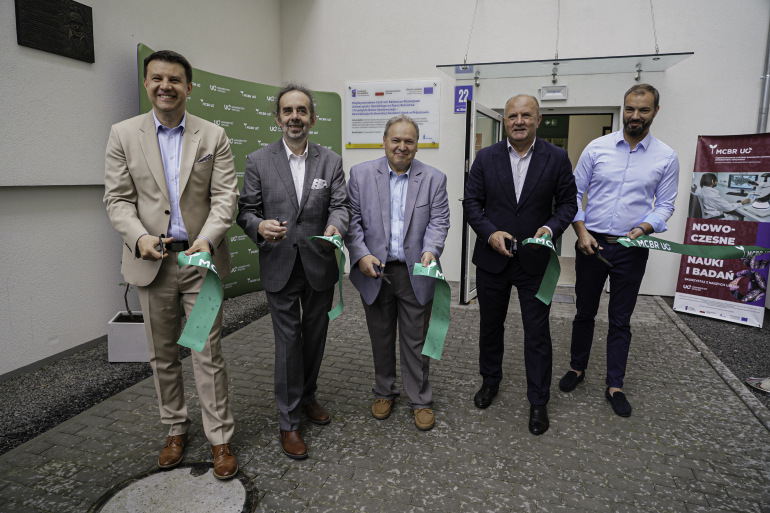International Research and Development Centre opened

Food, water and soil samples, wastewater, fertilisers or industrial waste, among other things, can be tested and studied at the International Research and Development Centre of the University of Opole (MCBR UO) for Agriculture and Food Industry, which was opened on 21 June.
“We are rebuilding something that was an intrinsic asset 150 years ago, and we hope to restore its shine,” with these words, the Rector of the University of Opole, Professor Marek Masnyk, opened the inauguration of the UO International Research and Development Centre for Agriculture and Food Industry. “We started this project in 2020. After three years, we gather within the walls of a perfectly equipped facility that will serve science and the socio-economic environment.”
The UO Rector noted that the UO MCBR was a project with a total cost of almost PLN 45 million, of which more than PLN 11 million was the UO's own contribution. “I am convinced that this place will serve the university, the region and the city and will meet the challenges of not just the 21st, but the 22nd century as well,” added Prof. Masnyk.
“The PLN 30 million in funding from the Opole Regional Operational Programme for this project is just a beginning. Now it is necessary to build a research base, so that young scientists have a place to realise their initiatives,” said Andrzej Buła, Marshall of the Opole Voivodeship, at a press conference organised before the opening of the MCBR UO. “This will involve a very important partner, i.e. the agriculture and food sector, which is developing very well in the Opole voivodeship.”
The first issue that the Centre will focus on is the problem with the Odra River. As Prof. Jacek Lipok, Vice-Rector for Science explained “studies related to the Odra River are being initiated and our university, together with the University of Szczecin, will in a way put this issue in frames. We are the first university on the Odra on the Polish side, and the University of Szczecin closes the course of the river. Thanks to our joint venture, we will therefore know its state at the entry and its state at the exit. So it is not only agriculture and food industry that will be the focus of research and interest for the excellent staff of the UO MCBR. The research base and apparatus that we have at our disposal thanks to the implementation of this project will make it possible to carry out such an undertaking as, for example, the study of bottom sediments or the quality of the Odra's waters. This will all take place on the basis of the facilities created thanks to this project.”
The opening of the MCBR UO was accompanied by a tour of the facility in Opole, as well as a conference organised in the Auditorium Hall at Oleska 48. The conference was divided into two parts: presentations given by representatives of the world of science and the world of business. In the first part, Prof. Jerzy Lis gave a lecture entitled "DNA barcoding - potential applications in research related to agriculture and the food industry", Prof. Tomasz Ciesielczuk tried to answer the question "Organic waste - an opportunity or affliction for modern man?", and Prof. Izabela Jasicka-Misiak delivered a lecture entitled "The quality of substances of natural origin as an important factor in their use for the benefit of health” The presentations by representatives of the business world and business environment institutions were commenced by Magdalena Woźniak of SFD SA, who spoke about the quality of dietary supplements, then Arnold Czech from Solanum Group Sp. z o.o. spoke about the research potential for agriculture of Solanum Group Sp. z o.o., and finally Marek Dryjański of Nutricia Polska Sp. z o.o. spoke about consumers with special sensitivities.
“Today we are not really finalising anything, except for the project process. Today we are only starting," said a member of the Opole Voivodeship Board, Szymon Ogłaza during the conference. “We are beginning the operation of an extremely important entity. Today it is difficult to imagine innovation in enterprises without the participation of research and development entities. We are inaugurating the operation of an excellent, I hope, entity."
“From the perspective of the city of Opole, there is no money better invested than in the development of the University of Opole. Not for the first time, the University of Opole shows that if it has an opportunity, it can turn its human, research and intellectual potential into action very well," added the Deputy Mayor of Opole, Maciej Wujec, “May there be more such projects. Congratulations and many thanks.”
The UO MCBR is a modern R&D centre, equipped with state-of-the-art equipment to conduct comprehensive and professional research for agriculture and food industry. It is a unique multidisciplinary unit, which has been established thanks to the efforts of the experienced scientific staff of the University of Opole representing: the Institute of Chemistry, the Institute of Biology, the Institute of Environmental Engineering and Biotechnology and the Institute of Socio-Economic Geography and Spatial Management.
The MCBR UO was developed as part of the project entitled 'International Research and Development Centre of the University of Opole for Agriculture and Food Industry - Revitalisation of the Royal Academy of Sciences in Prószków'. The project received funding under the Opole Regional Operational Programme 2014-2020. The total cost of construction, equipment and design amounted to almost PLN 45 million, while the requested amount of support was almost PLN 30.7 million.
The contract for this project was concluded on 9 March 2020. Construction work in Opole and Prószków began in November 2020 and was completed in January 2023, resulting in a fully equipped three-storey MCBR UO building close to the UO campus at ul. Oleska with a floor area of over 2,500 sq. meters and a laboratory building in Prószków on the premises of the former Royal Pomological Institute with an overall area of 200 sq. meters. Scientists will also be able to use a greenhouse with an area of 50 square meters, a height of over 3.6 m and a capacity of over 210 cubic meters. The unit comprises 18 research laboratories. Six of them carry out commercial activities in industrial research and development.

